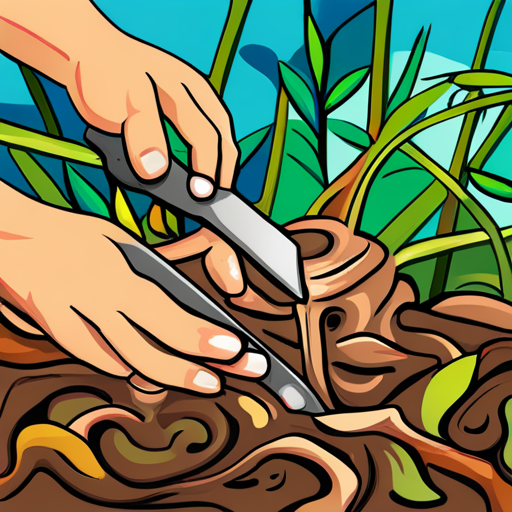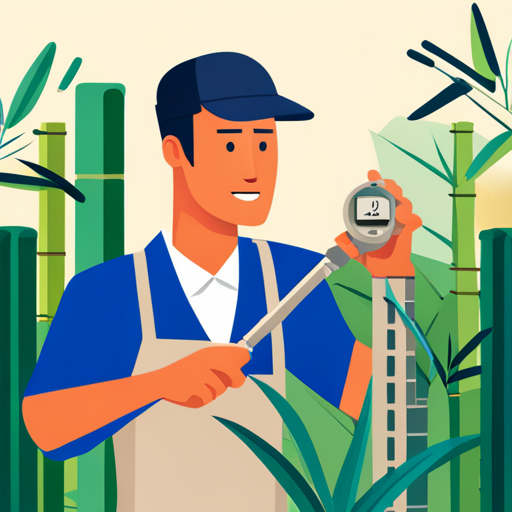Contents
- 1 Reviving Unhealthy Outdoor Bamboo Plants: Common Issues and Solutions
- 1.1 Our Highlighted Points
- 1.2 What’s wrong with it?
- 1.3 Identifying the causes
- 1.4 Addressing specific issues
- 1.5 Preventing future problems
- 1.6 How Can Composting Help in Reviving Unhealthy Outdoor Bamboo Plants?
- 1.7 Frequently Asked Questions
- 1.7.1 Can bamboo plants recover from severe damage or decline?
- 1.7.2 How long does it typically take for bamboo plants to regain their health?
- 1.7.3 What are some signs that indicate a problem with the bamboo plant’s health?
- 1.7.4 How can I determine the specific variety of bamboo I have?
- 1.7.5 Are there any specific care tips for bamboo plants grown in containers?
Reviving Unhealthy Outdoor Bamboo Plants: Common Issues and Solutions
Outdoor bamboo plants can sometimes suffer from various health issues, which can lead to their decline or even death. Identifying the causes behind these problems is crucial in order to implement appropriate solutions and revive the plants. This article aims to provide valuable insights into the common issues faced by outdoor bamboo plants and offer effective solutions to address them.
One of the primary reasons for bamboo plant problems is the mismatch between the plant’s natural climate and the prevailing conditions. Harsh winds and inappropriate temperatures can cause stress and damage to the plants, resulting in their poor health. Additionally, a constricted root system or watering issues can further exacerbate the situation.
By accurately identifying the specific issues affecting the bamboo plants, it becomes possible to address them individually, starting with the most likely cause. Adjusting watering frequency, improving drainage, providing shade, and addressing pest infestations are some of the potential solutions that can help revive the plants and restore their health.
Furthermore, preventing future problems is equally important. Understanding the specific needs and optimal conditions for the particular bamboo variety can greatly contribute to its overall well-being. Patience is crucial in the recovery process, as it may take time for the plants to regain their vitality.
By following the guidelines provided in this article, individuals can effectively revive their unhealthy outdoor bamboo plants and ensure their long-term health and beauty.
Our Highlighted Points
- Reviving a dying bamboo is possible if there are signs of stress or damage and if there is still some life left in the plant.
- Assess the bamboo and its symptoms to determine the causes of its health issues and address each cause one by one, starting with the most probable one.
- Providing optimal conditions for the specific bamboo variety, such as suitable climate, shade, and repotting for container bamboo, is important for its survival.
– Proper watering is essential for bamboo, as both underwatering and overwatering can cause problems. Addressing watering issues promptly can prevent permanent damage.
What’s wrong with it?

The identification and assessment of the symptoms exhibited by the outdoor bamboo plants are crucial in determining the specific causes of their poor health or decline. By carefully observing the plant, gardeners can identify various symptoms that may indicate underlying issues.
Diagnostic techniques such as examining the color and condition of the leaves, culms, and roots can provide valuable insights into the plant’s health. Yellowing of leaves, browning, curling, and drooping are common symptoms that can indicate different problems, including nutrient deficiencies, pest infestations, water issues, or environmental stress.
Additionally, assessing the overall growth and vigor of the bamboo plant can help identify whether it is experiencing general decline or specific issues. It is essential to thoroughly evaluate these symptoms to accurately diagnose the problems and implement appropriate solutions to revive the unhealthy outdoor bamboo plants.
Identifying the causes

Identifying the causes of poor health or decline in bamboo plants involves assessing the symptoms and analyzing possible factors. One important step in this process is identifying the stressors that may be affecting the plant.
These stressors can include factors such as harsh winds, incorrect climate or conditions, constricted root systems, or watering issues. Additionally, understanding the specific variety of bamboo is crucial in pinpointing the reasons for its poor health. Different bamboo varieties have different requirements and susceptibilities, so knowing the specific needs of the plant can help in determining the causes of its decline.
By carefully assessing the bamboo and its symptoms, gardeners can begin to address each cause one by one, starting with the most probable one, while also providing optimal conditions for the specific bamboo variety. Patience is key during this process, as recovery may take time for the plants to regain their health.
Addressing specific issues

Addressing specific issues requires a systematic approach to identify and resolve the underlying factors affecting the health of bamboo plants. When it comes to reviving unhealthy outdoor bamboo, two common issues that need to be addressed are root system problems and proper watering techniques.
Root system problems:
- Constricted root system: Repotting container bamboo every 2 to 3 years can prevent the roots from becoming constricted and promote healthy growth.
- Water-logged soil: Improving drainage in clay-heavy soil can prevent water-logging, which can lead to yellowing culms and leaves. Cutting off affected culms can also help.
Proper watering techniques:
- Underwatering: Soaking the soil thoroughly and adjusting watering frequency can help recover from leaf curling.
- Overwatering: Reduce watering frequency and improve drainage by incorporating well-draining materials into the soil to address drooping leaves.
By addressing these specific issues, bamboo plants can regain their health and thrive in their outdoor environment.
Preventing future problems

To prevent future problems with bamboo plants, it is important to focus on providing optimal conditions and addressing potential concerns.
Watering techniques play a crucial role in maintaining the health of outdoor bamboo plants. It is essential to strike a balance between underwatering and overwatering, as both can lead to issues. Regularly check the moisture level of the soil and adjust watering frequency accordingly. Additionally, it is recommended to water deeply, ensuring that the water reaches the root system.
Proper soil maintenance is also necessary to prevent future problems. Bamboo plants thrive in well-drained soil, so it is important to ensure good drainage. Incorporating well-draining materials, such as sand or gravel, into the soil can help improve drainage.
Regularly monitoring and maintaining optimal watering techniques and soil conditions will help prevent future problems and ensure the health and vitality of outdoor bamboo plants.
How Can Composting Help in Reviving Unhealthy Outdoor Bamboo Plants?
Composting offers a sustainable composting solution for yard waste, aiding in the revival of unhealthy outdoor bamboo plants. By converting yard waste into nutrient-rich compost, the soil’s fertility is enhanced, providing essential nourishment to bamboo plants. Composting also improves soil structure, moisture retention, and promotes beneficial microbial activity, ultimately contributing to the overall health and well-being of outdoor bamboo.
Frequently Asked Questions
Can bamboo plants recover from severe damage or decline?
Severe damage or decline in bamboo plants can be addressed and potentially reversed with appropriate techniques. By identifying the causes of poor health and implementing solutions such as addressing climate and conditions, providing shade, repotting, proper watering, and addressing nutrient deficiencies, damaged bamboo plants have the potential to recover.
How long does it typically take for bamboo plants to regain their health?
The timeline for bamboo plant recovery depends on various factors, including the severity of the plant’s health issues, the specific variety of bamboo, and the effectiveness of the measures taken to address the underlying problems.
What are some signs that indicate a problem with the bamboo plant’s health?
Common signs of unhealthy bamboo plants include yellowing leaves, browning leaves, leaf curling, drooping leaves, and the presence of pests. Diagnosing the specific issue is crucial in order to provide the appropriate treatment and revive the plant’s health.
How can I determine the specific variety of bamboo I have?
Determining the specific variety of bamboo can be done by examining the plant’s characteristics such as size, color, and leaf shape. Consulting plant identification guides or experts can also help in identifying the bamboo variety accurately.
Are there any specific care tips for bamboo plants grown in containers?
Container gardening tips for bamboo plants include choosing a well-draining soil mix that is rich in organic matter. Ensure the container has good drainage holes and repot the bamboo every 2 to 3 years to prevent a constricted root system.

